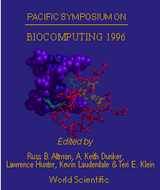Empirical free energy calculations of human immunodeficiency virus type 1 protease crystallographic complexes. II. Knowledge-based ligand-protein interaction potentials applied to thermodynamic analysis of hydrophobic mutations
Verkhivker GM
Agouron Pharmaceuticals, Inc., San Diego, CA 92121-1121, USA.
Pac Symp Biocomput. 1996;:638-52.

Abstract
Empirical free energy calculations of HIV-1 protease crystallographic complexes based on the developed knowledge-based ligand-protein interaction potentials have enabled a detailed thermodynamic analysis. Binding free energies are estimated within an empirical model that postulates that hydrophobic effect, mean field ligand-protein interaction potentials and conformational entropy changes are the dominant forces that determine complex formation. To provide a quantitative framework of the binding thermodynamics contributions the derived knowledge-based potentials have been linked with the hydrophobicity and conformational entropy scales originally developed to explain protein stability. The comparative analysis of studied inhibitors provides reasonable estimates of distinctions in their binding affinity with HIV-1 protease and gives insight into the nature of the binding determinants. The binding free energy changes upon a simple hydrophobic mutation Ile -> Val in the JG-365, MVT-101 and U75875 inhibitors of HIV-1 protease have been evaluated within a model that includes the effects of solvation, cavity formation, conformational entropy and mean field ligand-protein interactions. In general, free energy changes associated with a particular perturbation of a system can not be rigorously decomposed into separate terms from first principles. We explored the relationships between the changes in hydrophobic contributions and mean field ligand-protein interaction energies in the context of a totally buried and dense area of the binding site. We assume, therefore, that these simple hydrophobic deletions would not induce noticeable conformational changes in the enzyme and can be interpreted with some confidence in the framework of the model. The analysis has revealed the decisive effect of the energetics of ligand-protein interactions on the estimated free energy changes.
[Full-Text PDF] [PSB Home Page]